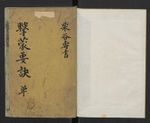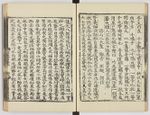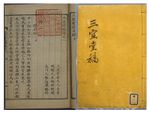2018 JSG Summer Hanmun Workshop (Intermediate)
This Wikisite is constructed by Kim Hayoung 김하영 with the help of An Sungjun 안승준, Chung Suhwan 정수환, and Yun Jinyoung 윤진영.
목차
- 1 Description
- 2 Class
- 3 수강생 Participants
- 4 Schedule
- 5 Translation
- 6 List of Hanmun Text
- 7 Text translated by Individual Project
- 8 Original Script
- 8.1 VI-3. Chuk puin chŏn(竹夫人傳) translated by Petra Sváková
- 8.2 VI-4. 李珥 - 擊蒙要訣 (讀書章第四, 事親章第五) translated by Jelena Gledić
- 8.3 VI-5. translated by Student 5
- 8.4 VI-6. 洛山二大聖 觀音·正趣 調信 translated by Francisca Cho
- 8.5 VI-7. 送二女子歸序 translated by Kyrie
- 8.6 VI-8. translated by Student 8
- 8.7 VI-9. translated by Student 9
- 8.8 VI-10. 善德王知幾三事, Queen Sŏndŏk foresees three events, from Samguk yusa translated by Althea Volpe
Description
The purpose of this course is to provide students an intensive training in what is commonly referred to as “classical Chinese,” or hanmun, which constitutes the nucleus of the literary languages of premodern China, Korea, and Japan. Because this workshop is intended for future researchers and scholars of premodern Korean culture in a broader context of East Asian civilization, which some call the “Sinosphere,” we will focus on the most fundamental sentence patterns and grammatical devices commonly used in hanmun, exploring some canonical texts that embody the linguistic and cultural grammars of classical Chinese literature. Each day, the class will study grammatical devices and patterns with simple sentences and read (excerpts of) regular hanmun texts for applied practice. We will read and critically analyze the texts, with which to formulate an academically-minded English translation of them. At the end of the workshop, students are expected to become familiar with different types of texts, to gain first-hand knowledge around the original texts of old Korean books, and more importantly, to become intellectually independent in their own future research critically engaging primary texts.
Class
A daily class is divided into three sessions. In Session 1 we read Pak Semu’s 朴世茂 (1487–1554) treatise to initiate students into Confucian literacy, Tongmong sŏnsŭp 童蒙先習 (Preparatory Learning for the Youth). Session 2 comprises studying syntactic and morphological patterns established by grammatical words, building up from the simplest forms to the more complex. This part of instruction will make use of the two representative primers of Chosŏn: the Ch’ugu 推句 (Versed Lines), a collection of quatrains epitomizing hanmun verses for those who have finished Ch’ŏnjamun 千字文 (Thousand-character Text); and the Hagŏjip 學語集 (Collection of Sentences for Learning), a collection of short prose-sentences to initiate beginners in hanmun texts. Learning with Ch’ugu and Hagŏjip allows us to experience both poetic- and prose-style sentences. The first two sessions will intensively engage two fundamental practices of hanmun literacy: parsing (both vocal and visual) and close reading. In Session 3 we translate various excerpts from actual literary pieces from China and Korea, applying the practices we learn in the first two sessions. The underlying focus of the study progresses as follows:
- Week 1 : basic structure, predication and commenting, parts of speech and word order, substantives and predicatives, nouns and pronouns, action verbs and stative verbs, adverbs, etc.
- Week 2 : discourse and context, parallelism and correspondence, building contexts and “dragging”, conjunctives and connectives, 語氣詞 and 語助詞
- Week 3 : intertextuality, allusions, and pattern, literary precedents and elicitors
Reading the original text together, parsing its sentences, and carefully analyzing parts both syntactically and semantically, which will form a basic training of translation. The instructor will give lectures when needed, to reinforce the knowledge of grammatical words, information on reference tools, and relevant sociocultural context of fundamental importance. Each student will be responsible for looking up and learning unfamiliar hantcha, practicing to punctuate sentences that were studied in the previous classes, and participating in drafting translations. The outcome of translation will be archived and shared.
Instructor
수강생 Participants
- 참가자 명단 Participants List cf. 역대 참가자 Previous Participants
| 연도 | 성명 | 국적 | 소속 | 직위 | 연구/전공분야 | 그룹 |
|---|---|---|---|---|---|---|
| 2018 | Cho, Francisca | 미국 USA |
미국 조지타운대학교 Georgetown University |
교수 Associate Professor |
Buddhism | Intermediate Training Group |
| 2018 | Lin, Nan Kathy | 미국 USA |
미국 조지타운대학교 Georgetown University |
박사과정 Doctoral Student |
- | Intermediate Training Group |
| 2018 | Svakova, Petra | 체코 Czech |
한국 성균관대학교 Sungkyunkwan University |
석사과정 Master's Student |
East Asian Studies | Intermediate Training Group |
| 2018 | Vermette, Kyrie | 캐나다 Canada |
캐나다 브리티시 컬럼비아대학교 University of British Columbia |
박사과정 Doctoral Student |
Korean History | Intermediate Training Group |
| 2018 | Sauvadet, Bryan | 프랑스 France |
프랑스 파리7대학교 Paris Diderot University (Paris VII) |
석사과정 Master's Student |
Korean Studies /Korean Art History /Korean Religious Studies | Intermediate Training Group |
| 2018 | Volpe, Althea | 이탈리아 Italy |
이탈리아 사피엔자대학교 La Sapienza University |
석사과정 Master's Student |
- | Intermediate Training Group |
| 2018 | Gledic, Jelena | 세르비아 Serbia |
세르비아 베오그라드대학교 University of Belgrade |
강사 Lecturer |
Cultural Studies /Identity studies, Chinese history | Intermediate Training Group |
| 2018 | Chae-Duporge, Okyang | 프랑스 France |
프랑스 국립동양학대학교 INALCO |
강사 Lecturer |
- | Intermediate Training Group |
| 2018 | Butterfield, James Julian | 캐나다 Canada |
캐나다 토론토대학교 University of Toronto |
석사과정 Master's Student |
- | Intermediate Training Group |
| 2018 | Rzanna, Ewa | 폴란드 Poland |
폴란드 세종학당 & 아담 미츠키에비치 대학교 King Sejong Institute & Adam Mickiewicz University |
연구원 Researcher |
- | Intermediate Training Group |
Schedule
- Session 1 - 9:00–10:30 AM
- Session 2 - 10:40–12:00 AM, 1:00–2:00 PM
- Session 3 - 2:10–4:00 PM
the 3-Week Schedule - View Details
| Date | Contents | |
|---|---|---|
| 7/2 | S1: Opening Ceremony, Placement Test
S2: Introduction: Classical Chinese, literary Chinese, Sino-Korean, and Hanmun |
|
| 7/3 | S1: Tongmong sŏnsŭp 1–4
S2: Ch’ugu 1, 4; Hagŏjip 1–5 S3: Short passages 8, 23, 43 |
|
| 7/4 | S1: Tongmong sŏnsŭp 5–8
S2: Hagŏjip 6–10
|
Field Trip
|
| 7/5 | S1: Tongmong sŏnsŭp 9–13
S2: Ch’ugu 5, 7, 9; Hagŏjip 11–15 S3: Short passages 10, 13, 16 |
|
| 7/6 | S1: Tongmong sŏnsŭp 14–17
S2: Ch’ugu 13, 15, 16; Hagŏjip 16–20 S3: Short passages 9, 15, 24 |
|
| 7/9 | S1: Tongmong sŏnsŭp 18–22
S2: Ch’ugu 18, 19; Hagŏjip 21–25 S3: Short passages 4, 11, 12 |
|
| 7/10 | S1: Tongmong sŏnsŭp 23–25
S2: Ch’ugu 22, 24, 30; Hagŏjip 26–30 S3: Short passages 1, 11, 33, 37 |
|
| 7/11 | S1: Tongmong sŏnsŭp 26–30
S2: Hagŏjip 31–35
|
Special Lecture
|
| 7/12 | S1: Tongmong sŏnsŭp 31–34
S2: Ch’ugu 32, 37, 39; Hagŏjip 36–40 S3: Short passages 5, 17, 20, 38 |
|
| 7/13 | S1: Tongmong sŏnsŭp 35–38
S2: Hagŏjip 41–45
|
Field Trip
|
| 7/16 | S1: Tongmong sŏnsŭp 39–42
S2: Ch’ugu 41, 46, 50; Hagŏjip 46–50 S3: Short passages 21, 27, 36 |
|
| 7/17 | S1: Tongmong sŏnsŭp 43–47
S2: Hagŏjip 51–55
|
Special Lecture
|
| 7/18 | S1: Tongmong sŏnsŭp 48–52
S2: Ch’ugu 56, 57, 58; Hagŏjip 56–60 S3: Short passages 2, 6, 43 |
|
| 7/19 | S1: Tongmong sŏnsŭp 53–56
S2: Ch’ugu 59, 60; Hagŏjip Review 1 S3: Short passages 29, 34, 42 |
|
| 7/20 | S1: Tongmong sŏnsŭp Review
S2: Ch’ugu Review; Hagŏjip Review 2 S3: Short passages 28, 44 |
Translation
We aim to practice academic translation. An academic translation should prove to be comprehensive to an intellectual reader for whom no previous knowledge of or about the text is assumed, rendered in a clear, precise, yet hermeneutically nuanced language. There are four aspects of concentration in our training:
- (1) Faithfulness to the original text
- (2) Linguistic clarity of the translating language
- (3) Detailed annotation to integrate contextual and intertextual information
- (4) Observance of academic convention for translation
List of Hanmun Text
- Session 1 : Tongmong sŏnsŭp 童蒙先習 (Preparatory Learning for the Youth)
- Session 2 : Ch’ugu 推句 (Versed Lines)
- Hagŏjip 學語集 (Collection of Sentences for Learning)
- Session 3 : Excerpts for practice
Session 1: 童蒙先習 Preparatory Learning for the Youth
The Tongmong sŏnsŭp is a well-known hanmun primer for novices after their initiation in hantcha with the Chŏnjamun 千字文. Its text spells out the fundamental ethico-historial framework of Confucianism, quoting and alluding most frequently used 2018 童蒙先習 in the traditional discourse of moral maxims. Its language is prosodic and suitable for vocal reading and reciting. The introduction delineates the ethics based on the Five Cardinal Relations (oryun 五倫), followed by an overview of Chinese and Korean histories as realizing ethical principles endowed in human civilization. Its authorship had been generally attributed to Pak Semu 朴世茂 (1487–1554), though some recorded Kim An’guk 金安國 (1478–1543) as its author. Yun Insŏ’s 尹仁恕 postface, included in the 1543 edition (printed at the P’yŏngan Magistrate Office), states that Min Chein 閔齊仁, then P’yŏngan Magistrate, co-authored this work. A recent discovery of a block-printed edition bearing Min Chein as the author strongly suggests that Min authored it before Pak did because it predates the manuscript edition that recorded Pak Semu as the author, which had been known as the earliest edition. Authorship aside, however, it appears reasonable to assume that the sentences in the Tongmong sŏnsŭp were commonly shared for pedagogical purposes among the literati since early Chosŏn. As it has also been used at the court to instruct royal princes since King Hyŏnjong’s reign (1659–1674), there are a number of prints and manuscripts extant. The 1759 edition especially contains King Yŏngjo’s 英祖 preface and Song Siyŏl’s 宋時烈 (1607–1689) postface, indicating that it was received widely.
| date | 童蒙先習 |
|---|---|
| 7/03 | 童蒙先習 01 - 04 |
| 7/04 | 童蒙先習 05 - 08 |
| 7/05 | 童蒙先習 09 - 13 |
| 7/06 | 童蒙先習 14 - 17 |
| 7/09 | 童蒙先習 18 - 22 |
| 7/10 | 童蒙先習 23 - 25 |
| 7/11 | 童蒙先習 26 - 30 |
| 7/12 | 童蒙先習 31 - 34 |
| 7/13 | 童蒙先習 35 - 38 |
| 7/16 | 童蒙先習 39 - 42 |
| 7/17 | 童蒙先習 43 - 47 |
| 7/18 | 童蒙先習 48 - 52 |
| 7/19 | 童蒙先習 53 - 56 |
| * | 御製童蒙先習序 |
| ** | 跋文 |
Session 2-1: 推句 Versed Lines
The Ch’ugu is a collection of pentasyllabic quatrains (o’ŏn chŏlgu 五言絕句) for beginners of hanmun during the Chosŏn dynasty. There are altogether 60 quatrains, many chosen from known poetic lines, containing motifs and images familiar to novices. It is one of the typical primers taught to learners who have finished character lessons with, most likely, the Ch’ŏnjamun 千字文, along with the Saja sohak 四字小學 [Four-character Minor Learning], Tongmong sŏnsŭp, and Kyŏngmong yogyŏl 擊夢要訣 [Essential precepts to awake the unenlightened]. The title "Ch’ugu" could be taken as “selected lines” (ch’u 推 “to select”) but also have come from ch’ugo (or proscriptively pronounced t’oego) 推敲 “push or knock,” a verb coined for the story of Jia Dao 賈島 (780?–843) and Han Yu 韓愈 (768–824) to mean “polish or perfect the language of a literary work.”[1] Ch’ugu 推句 as a verb was then used in the sense of writing poems, and if it was indeed where the title was chosen, it would more precise to pronounce the title as t'oegu, not ch’ugu. All extant copies of Ch’ugu is in the form of manuscript, but as Ŏ Sukkwŏn’s 魚叔權 Kosa ch’waryo 攷事撮要 (1554) recorded the presence of its printing blocks in 1558, it is possible that Ch’ugu was more popular as a primer in mid-Chosŏn period.
- ↑ Jia Dao once composed a poem, sitting on a mule, which included lines, “Birds sleep on the tree in the middle of the pond, a monk knocks on the door under the moon” 鳥宿池中樹, 僧敲月下門. He was having second thought of using t’oe 推 “push” instead of ko 敲 “knock,” but could not decide. Occupied by this thought, he failed to step back to make way when Han Yu’s mayoral march was progressing the street, which was a serious offense. Han Yu summoned Jia Dao and interrogated why Jia did not step aside. After hearing what happened, Han Yu said that he preferred ko instead of t’oe, upon which they became good friends in literature. This story is introduced in the Tangshi jishi 唐詩紀事.
| date | 推句 |
|---|---|
| 7/03 | 推句 01, 04 |
| 7/05 | 推句 05, 07, 09 |
| 7/06 | 推句 13, 15, 16 |
| 7/09 | 推句 18, 19 |
| 7/10 | 推句 22, 24, 30 |
| 7/12 | 推句 32, 37, 39 |
| 7/16 | 推句 41, 46, 50 |
| 7/18 | 推句 56, 57, 58 |
| 7/19 | 推句 59, 60 |
| 7/20 | 推句 Review |
Session 2-2: 學語集 Collection of Sentences for Learning
The Hagŏjip is a manuscript whose authorship is unknown. It contains short sentences explaining various subjects ranging from heaven and earth to flowers and animals, for the purpose of teaching the basic sentence structure and grammatical patterns of literary Chinese to novices. It is often confused with Hagŏ 學語 compiled by Pak Chaech’ŏl 朴載哲 with a similar purpose. Hagŏ was blockprinted in 1868 by Pak Chaechŏl’s son Pak Kyujin 朴圭鎮. The two are quite different texts. The latter is more oriented in Confucian learning of moral principles and quotations from classics, whereas the former is apparently mindful of linguistic pedagogy and introduces syntactic patterns with gradually increasing complexity. There are a few manuscript editions preserved in various archives in Korea, including Jangseogak. It appears that there are some textual variations depending on editions especially with the selection of sentences, though individual sentences remain mostly the same.
Format
In the following, each sentence is given in three ways. First without punctuation, then with punctuation, and the last with t’o 토. Punctuation of literary Chinese provides where the sentence breaks into a series of clasuses and phrases, and thus clues to the meaning of the entire sentence. T’o is specific to Korean culture, in which people spoke a fundamentally different language from Chinese. Carrying a similar function to that of Japanese kaeriten 返点 (returning point), t’o adds grammatical words of Korean to points where the Chinese sentences breaks so that the grammatical relation between parts.
E.g. 學而時習之면 不亦悅乎아
if Q-ending
The traditional pedagogy of literary Chinese placed a great importance to t’o. It served as a device to train students in parsing sentences, as well as to help them read aloud and recite sentences.
After the sentence, key grammatical words and patterns will be introduced.
C: Clause P: Phrase V: Verb A: Adjective N: Noun Adv: Adverb
| date | 學語集 |
|---|---|
| 7/3 | 學語集 01 - 05 |
| 7/4 | 學語集 06 - 10 |
| 7/5 | 學語集 11 - 15 |
| 7/6 | 學語集 16 - 20 |
| 7/9 | 學語集 21 - 25 |
| 7/10 | 學語集 26 - 30 |
| 7/11 | 學語集 31 - 35 |
| 7/12 | 學語集 36 - 40 |
| 7/13 | 學語集 41 - 45 |
| 7/16 | 學語集 46 - 50 |
| 7/17 | 學語集 51 - 55 |
| 7/18 | 學語集 56 - 62 |
Session 3: 選讀 Short Passages for Practice
Excerpts for practice:
08. “Zhengren mai lü” 鄭人買履 [A person of Zheng state buys shoes], Han Fei zi 韓非子.
43. “Hyet’ong ch’ulga” 惠通出家 [Hyet’ong becomes a monk], Samguk yusa.
10. “Ke zhou qiu jian” 刻舟求劍 [Notching the boat to find the sword], Lüshi chunqiu 呂氏春秋.
16. “Zhao san mu si” 朝三暮四 [Three in the morning, four in the evening], Zhuangzi.
09. “Shou zhu dai tu” 守株待兔 [Waiting for a hare while guarding the tree], Han Fei zi.
15. “Hudie meng” 蝴蝶夢 [Butterfly dream], Zhuangzi 莊子.
24. “Haehak” 諧謔 [Witty stories], Yi Su-gwang李睟光, Chibong yusŏl 芝峯類說.
28. “Kiridan” 伎利檀 [Christianity], Ŏu yadam 於于野談 by Yu Mongin 柳夢寅.
39. “Hong Kisŏp” 洪夔燮, Myŏngsim pogam 明心寶鑑.
33. “Sŏkchin tan ji” 石珍斷指 [Sŏkchin cuts off his finger], Samgang haengsil-to.
37. “Yŏlbu ip kang” 烈婦入江 [A devoted wife enters the river], Samgang haengsil-to.
34. “Nubaek p’oho” 婁伯捕虎 [(Ch’oe) Nubaek captures the tiger], Samgang haengsil-to.
01. “Pak Hyŏkkŏse” 朴赫居世, Samguk sagi 三國史記.
42. “Ch’ŏyong-nang” 處容郎, Samguk yusa.
05. “Kui t’o chi sŏl” 龜兔之說 [Story of a tortoise and a hare], Samguk sagi.
11. “Hua she tian zu” 畫蛇添足 [Draw a snake and add feet], Zhanguo ce 戰國策.
38. “Kim-ssi pak ho” 金氏撲虎 [Lady Kim strikes the tiger], Samgang haengsil-to.
27. “Ch’ŏ pul yok chon” 妻不欲尊 [The wife doesn’t want to be respected], Ŏmyŏnsun禦眠楯.
36. “Pinyŏng tolchin” 丕寧突陳 [Pinyŏng charges at the enemy line], Samgang haengsil-to.
02. “Tongmyŏng sŏngwang” 東明聖王 [Tongmyŏng, the Sagacious King], Samguk sagi.
06. “Kyebaek” 階伯, Samguk sagi.
44. “Yŏno-rang Se’o-nyŏ” 延烏郞細烏女, Samguk yusa.
22. "Xushi" 虛實 [Emptiness and fullness], Sunzi bingfa 孫子兵法
(Poetry) Sample Classical Chinese Poems
Text translated by Individual Project
VI-0. (sample) 學琴師襄 translated by YO
VI-1. 大眾受學品 translated by Julian Butterfield
VI-2. The Four Kinds of Enlightenment from Chegwan's Tiantai Handbook translated by Kathy Lin
Original Script
| Classical Chinese | English |
|---|---|
|
初辨五時五味及化儀四教。然後出藏通別圓。第一頓教者。即華嚴經也。從部時味等。得名為頓。所謂如來初成正覺。在寂滅道場。四十一位法身大士。及宿世根熟天龍八部一時圍繞。如雲籠月。爾時如來現盧舍那身。說圓滿修多羅。故言頓教。若約機約教。未免兼權。謂初發心時便成正覺等文。為圓機說圓教。處處說行布次第。則為權機說別教。故約部為頓。約教名兼。此經中云。譬如日出先照高山(第一時)涅槃云。譬如從牛出乳。此從佛出十二部經(一乳味)法華信解品云。即遣旁人急追將還。窮子驚愕稱怨大喚等。此領何義。答諸聲聞在座如聾若啞等是也。第二漸教者(此下三時三味。總名為漸)次為三乘根性於頓無益故。不動寂場而游鹿苑。脫舍那珍御之服。著丈六弊垢之衣。示從兜率降下託摩耶胎。住胎出胎納妃生子。出家苦行六年已後。木菩提樹下以草為座成劣應身。初在鹿苑先為五人。說四諦十二因緣事六度等教。若約時則日照幽谷(第二時)若約味則從乳出酪。此從十二部經出九部修多羅(二酪味)信解品云。而以方便密遣二人(聲聞緣覺)形色憔悴無威德者。汝可詣彼徐語窮子。雇汝除糞。此領何義。答次頓之後說三藏教。二十年中常令除糞。即破見思煩惱等義也。次明方等部。淨名等經。彈偏折小。歎大褒圓。四教俱說。藏為半字教。通別圓為滿字教。對半說滿。故言對教。若約時則食時(第三時)若約味則從酪出生酥。此從九部出方等(三生酥味)信解品云。過是已後心相體信入出無難。然其所止猶在本處。此領何義。答三藏之後次說方等。已得道果心相體信。聞罵不瞋。內懷慚愧心漸淳淑。次說般若。轉教。付財。融通。淘汰。此般若中不說藏教。帶通別二正說圓教。約時則禺中時(第四時)約味則從生酥出熟酥。此從方等之後出摩訶般若(四熟酥味)信解品云。是時長者有疾自知將死不久。語窮子言。我今多有金銀珍寶倉庫盈溢。其中多少所應取與。此領何義。答明方等之後次說般若。般若觀慧即是家業。空生身子受勅轉教。即是領知等也。已上三味對華嚴頓教。總名為漸。第三祕密教者。如前四時中。如來三輪不思議故。或為此人說頓。或為彼人說漸。彼此互不相知。能令得益。故言祕密教。第四不定教者。亦由前四味中。佛以一音演說法。眾生隨類各得解。此則如來不思議力。能令眾生於漸說中得頓益。於頓說中得漸益。如是得益不同。故言不定教也。
|
(Work in progress) |
VI-3. Chuk puin chŏn(竹夫人傳) translated by Petra Sváková
VI-4. 李珥 - 擊蒙要訣 (讀書章第四, 事親章第五) translated by Jelena Gledić
VI-5. translated by Student 5
VI-6. 洛山二大聖 觀音·正趣 調信 translated by Francisca Cho
VI-7. 送二女子歸序 translated by Kyrie
VI-8. translated by Student 8
VI-9. translated by Student 9
VI-10. 善德王知幾三事, Queen Sŏndŏk foresees three events, from Samguk yusa translated by Althea Volpe







